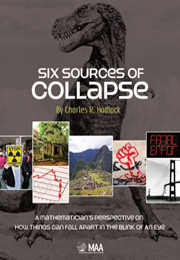 Six Sources of Collapse
Six Sources of Collapse The elephant's toenail
I remember a silly gimmick of one of my high school teachers back in Brooklyn, and the fact that I remember it so vividly after about fifty years makes me think it's worth retelling. I'm finally beginning to really appreciate it.
He showed us a huge blown-up dirty white picture of something that had no strong distinguishing features, a bit of nondescript texture, and that extended right to the boundary of the photo frame. Then he asked us to guess what it was that we were looking at. The whole class really got into this exercise with an impressive degree of creativity and energy. Everyone wanted to be the person with the correct guess. The teacher was being bombarded with suggestions. Hands were waving in the air. The suggestions probably included things like a garage floor, a subway platform, old kitchen linoleum, or maybe even the surface of the moon.
But no one got it. After all, who would have guessed that we were looking at an elephant's toenail? No one was thinking that this was the image of something such that if we had access to just a small additional amount of the photo field, everything would change drastically from what we were thinking about. Built into our way of thinking was that this image should extend off to the sides in a fashion similar to the part we could see and thus that there was a certain homogeneity to the structure of the object.
To save this book to your Kindle, first ensure no-reply@cambridge.org is added to your Approved Personal Document E-mail List under your Personal Document Settings on the Manage Your Content and Devices page of your Amazon account. Then enter the ‘name’ part of your Kindle email address below. Find out more about saving to your Kindle.
Note you can select to save to either the @free.kindle.com or @kindle.com variations. ‘@free.kindle.com’ emails are free but can only be saved to your device when it is connected to wi-fi. ‘@kindle.com’ emails can be delivered even when you are not connected to wi-fi, but note that service fees apply.
Find out more about the Kindle Personal Document Service.
To save content items to your account, please confirm that you agree to abide by our usage policies. If this is the first time you use this feature, you will be asked to authorise Cambridge Core to connect with your account. Find out more about saving content to Dropbox.
To save content items to your account, please confirm that you agree to abide by our usage policies. If this is the first time you use this feature, you will be asked to authorise Cambridge Core to connect with your account. Find out more about saving content to Google Drive.